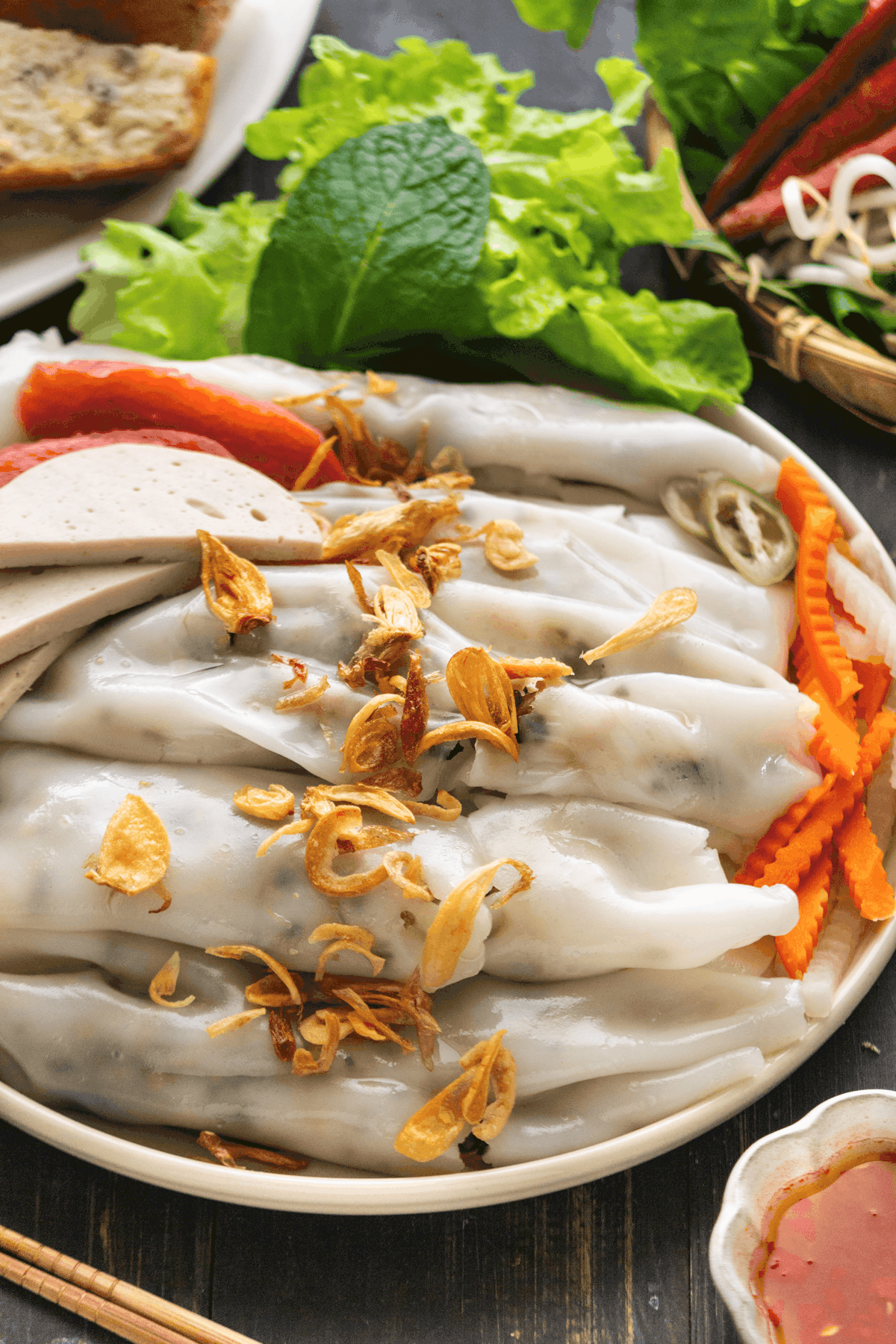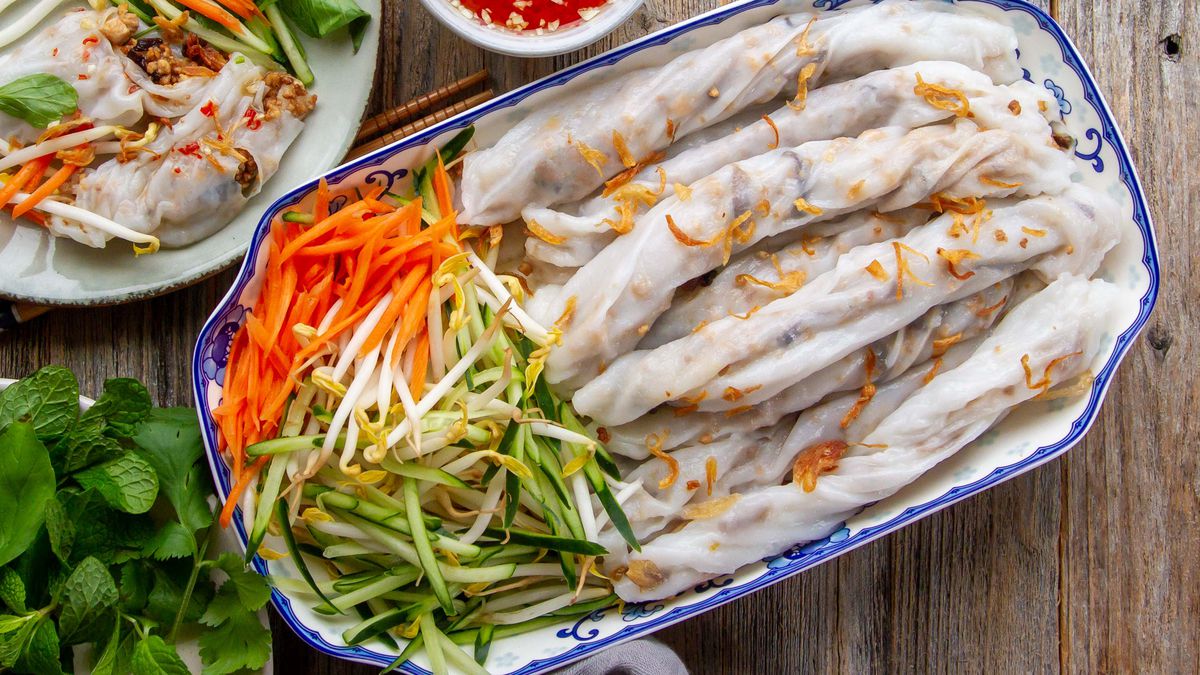Bánh Cuốn Recipe: A Delicious Vietnamese Delight
Bánh cuốn, a beloved Vietnamese dish, is a perfect combination of delicate rice rolls, savory fillings, and aromatic herbs. This dish is often enjoyed as a breakfast or a light lunch, making it an incredibly popular choice among locals and tourists alike. In this detailed recipe guide, we’ll dive into how to make this delicious dish at home, ensuring that you can recreate the authentic taste of Vietnam in your own kitchen.
What is Bánh Cuốn?
Bánh cuốn is a traditional Vietnamese dish made of steamed rice rolls filled with a savory mixture of ground pork, mushrooms, and minced shallots, often topped with fried shallots and fresh herbs. It’s served with a side of nước chấm, a Vietnamese dipping sauce, which adds a tangy and sweet flavor to the dish.
The soft rice rolls are slightly chewy, while the filling is flavorful and comforting. The dish is light yet filling, offering a perfect balance of textures and flavors that are loved by all who try it.

Ingredients for the Perfect Bánh Cuốn
To make authentic bánh cuốn at home, you’ll need the following ingredients:
For the Rice Rolls:
-
Rice flour (200g)
-
Tapioca starch (50g)
-
Water (500ml)
-
Salt (a pinch)
-
Vegetable oil (for steaming)
For the Filling:
-
Ground pork (200g)
-
Dried wood ear mushrooms (50g)
-
Shallots (2, minced)
-
Fish sauce (1 tablespoon)
-
Sugar (1 teaspoon)
-
Salt (to taste)
-
Black pepper (a pinch)
-
Vegetable oil (for frying)
For Serving:
-
Fried shallots (to garnish)
-
Fresh herbs (such as cilantro, mint, or Vietnamese perilla)
-
Nước chấm (Vietnamese dipping sauce)
How to Make Bánh Cuốn at Home
Making bánh cuốn at home may sound complicated, but with the right ingredients and technique, you’ll be able to master it easily. Follow this step-by-step guide to recreate the perfect bánh cuốn:
Step 1: Prepare the Rice Batter
To make the delicate rice rolls, start by mixing rice flour, tapioca starch, water, and a pinch of salt in a bowl. Whisk everything together until the batter is smooth and free of lumps. Let the batter sit for about 30 minutes. This resting time helps achieve the soft, chewy texture that bánh cuốn is known for.
Step 2: Make the Filling
While the rice batter is resting, prepare the filling. Soak the dried wood ear mushrooms in warm water for about 20 minutes until they become soft. Once softened, chop them into small pieces.
In a pan, heat a little vegetable oil and sauté the minced shallots until fragrant. Add the ground pork to the pan, cooking it until it turns golden brown. Add the chopped mushrooms, fish sauce, sugar, salt, and pepper. Stir to combine, cooking for an additional 5 minutes, and then set the filling aside.
Step 3: Steam the Rice Rolls
To steam the rice rolls, prepare a flat steamer tray or a cloth-lined steaming basket. Lightly grease the tray with vegetable oil. Pour a thin layer of the rice batter onto the tray and steam for about 3-5 minutes until the batter becomes firm and opaque.
Once the rice roll is steamed, place a small spoonful of the filling on top of the rice sheet, then carefully roll it up. Repeat the process for the remaining batter and filling.
Step 4: Serve Your Bánh Cuốn
Place the steamed rice rolls on a serving plate and garnish with fried shallots and fresh herbs. Serve with a side of nước chấm for dipping, adding a tangy, salty contrast to the soft rolls.

Tips for the Perfect Bánh Cuốn
-
Consistency of the Rice Batter: The key to perfect bánh cuốn lies in the consistency of the batter. It should be runny, but not too watery. If the batter is too thick, the rolls will be too dense.
-
Steaming Temperature: Make sure the steamer is at the right temperature before you start steaming the rice rolls. Too hot or too cold, and the texture may not be right.
-
Filling Variations: While ground pork and mushrooms are the traditional filling, you can experiment with other ingredients like shrimp, chicken, or even tofu for a vegetarian version.
-
Fresh Herbs: Don’t skip the fresh herbs! They add a burst of freshness and enhance the overall flavor of the dish.
Nutritional Benefits of Bánh Cuốn
Bánh cuốn isn’t just delicious – it’s also quite nutritious. Here’s a quick breakdown of its nutritional benefits:
-
Protein: The ground pork provides a good source of protein, which is essential for muscle repair and growth.
-
Fiber: The addition of wood ear mushrooms and fresh herbs adds fiber, which aids digestion and promotes gut health.
-
Low in Fat: Bánh cuốn is relatively low in fat, especially if you control the amount of oil used for frying.
-
Vitamins: Fresh herbs like cilantro and mint are packed with vitamins, including Vitamin A and Vitamin C, which support immune function and skin health.
Frequently Asked Questions (FAQs) about Bánh Cuốn
1. Can I make Bánh Cuốn in advance?
Yes, you can prepare the rice rolls and filling in advance, then refrigerate them. When ready to serve, simply steam them again for a few minutes to reheat.
2. Is Bánh Cuốn gluten-free?
Traditional bánh cuốn made with rice flour is naturally gluten-free. However, if you’re using a different type of flour, always check the ingredients for gluten.
3. Can I make Bánh Cuốn without a steamer?
If you don’t have a traditional steamer, you can use a large pot with a lid and a steam rack. Just make sure the water level doesn’t touch the tray with the rice batter.
4. What can I serve with Bánh Cuốn?
Bánh cuốn is often served with a side of nước chấm, Vietnamese dipping sauce. It pairs wonderfully with pickled vegetables or a simple salad for a complete meal.
Conclusion
Bánh cuốn is an incredibly versatile dish that embodies the rich flavors of Vietnamese cuisine. Whether you’re a seasoned cook or a beginner, this recipe will help you create an authentic and delicious dish that’s sure to impress your family and friends. By following the steps carefully and experimenting with different fillings, you can enjoy this Vietnamese classic any time.
Remember, the key to the perfect bánh cuốn lies in the texture of the rice rolls, the savory filling, and the refreshing herbs. With a little practice, you’ll soon be making bánh cuốn like a pro. So why not give it a try and bring the flavors of Vietnam into your kitchen today?

